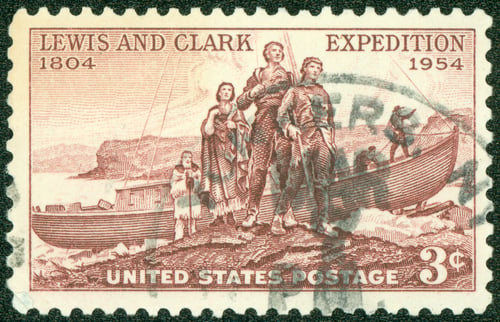On November 15, 1805, the Lewis and Clark Expedition reached the shores of the Pacific Ocean a year and a half after starting out from St. Louis, Missouri. They poled keel boats and sometimes walked their way up the Missouri River to its headwaters in Montana, were the first Americans to cross the Continental Divide, and canoed down the Columbia River system to near what is now Portland, Oregon. The Lewis & Clark Expedition was a remarkable achievement, and the West would never be the same.
Only two years earlier, President Thomas Jefferson had completed the Louisiana Purchase from the French leader Napoleon. The area encompassed essentially all the land west of the Mississippi River that drained into the Mississippi. The Purchase doubled the land mass of the United States and added what would eventually become all or part of 15 states, including much of Colorado. The price was $15 million – less than three cents an acre.

AI Portrayal of the Lewis and Clark Expedition
President Jefferson’s intentions with the expedition were to learn about the newly acquired land, secure the United States’ claim to what became the Oregon Territory, and look for the fabled Northwest Passage – a water route through the continent. Little did he or anyone else foresee the consequences the expedition would have on the plants, animals, and indigenous people who had already been there for tens of thousands of years.
Although it was not their primary mission, the Lewis and Clark Expedition collected 122 species of animals and 178 species of plants never before known to western science, including the grizzly bear, bighorn sheep, and prairie dog. Their detailed journals contained information from local tribes about the medicinal value of many of the plants they recorded. They prepared over 140 maps that noted landmarks, friendly vs. “hostile” Native Americans, water sources, and Indian trails. These maps greatly aided future explorers and settlers, including providing the basic route for the Oregon Trail.
During their travels, Lewis and Clark established relationships with over two dozen different Indian tribes. Most of these encounters were friendly, though sometimes tense. Without the assistance and knowledge of local tribes, Lewis and Clark would likely have never succeeded, much less returned alive. A Shoshone women, Sacagawea, and her newborn baby, joined the Expedition during the winter of 1804-1805, and served as both an interpreter and liaison with other tribes.

Lewis and Clark Expedition United States Postal Stamp
In the decades following the expedition, Americans grew to be enamored by Manifest Destiny – the doctrine that Americans had the divine right to settle across North America, and that it was the will of God that they “civilize” the West and “tame” the Wilderness.
Within 50 years of the Lewis and Clark Expedition, the United States began to wage wars on the Native Americans, forcing them onto reservations. Millions of American bison were slaughtered – almost driving bison into extinction and removing an important source of sustenance for Native Americans. The prairie was plowed, the transcontinental railroad was completed in 1869, towns were established, forests were cut down, and ecosystems were irreversibly altered. The promise of gold and new opportunities drew hundreds, then thousands, and then millions of settlers to the West.
By the end of the 19th Century, America was well on its way to becoming a world power. The vastness of the West helped shape the American character and its outlook on the world. And to think, all of this can be traced back, at least in part, to a few hardy explorers who headed up the Missouri River and into the great unknown.
Mike Browning is a volunteer wilderness ranger with the Eagle Summit Wilderness Alliance, an all-volunteer nonprofit group that works with the USFS to protect the four Wilderness areas in Eagle and Summit Counties







